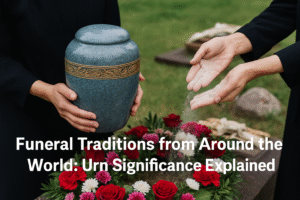1. Sky Burials to Sacred Urns: Funeral Rituals Around the World That Might Leave You Speechless…

Death is universal, but what happens afterward varies drastically across the globe. While some cultures treat the dead with solemn silence, others celebrate their life with colors, dance, and fire. What’s often overlooked is how ashes — and urns — play a surprisingly central role in these traditions.
Let’s journey across continents and unravel the sacred, the symbolic, and sometimes even the shocking ways humanity honors its dead.
Tibet: Where the Dead Feed the Living Sky
In the high mountains of Tibet, families perform the mysterious sky burial, a ritual where the body is placed atop a mountain and offered to vultures. This practice is rooted in Buddhism, where the body is seen as an empty vessel after death — what matters is the soul’s journey.
There are no urns in this tradition. Instead, the circle of life is honored. Ashes are not preserved, because the body is entirely consumed. It’s haunting, yet deeply spiritual.
Japan: Bone Picking and Ashes in Sacred Boxes
In Japan, death rituals are filled with reverence. After cremation, family members gather for a rare and intimate custom called kotsuage — where they use chopsticks to pick bones from the ashes and place them into a ceramic urn.
Each bone is placed with precision, starting from the feet and ending with the head — to keep the spirit “upright.” The urn is then sealed and often buried in a family grave, visited regularly during Obon, a Buddhist event where spirits return.
India: From Sacred Rivers to Floating Urns
India’s Hindu traditions view fire as the ultimate purifier. Bodies are cremated on open-air pyres, particularly along the Ganges River. The ashes, called “asthi,” are then either collected in small urns or directly immersed in holy rivers.
However, modern families sometimes opt for floating urns — biodegradable containers made from clay or leaf pulp, which dissolve naturally after release.

Funeral Rituals from Around the World: What Urns, Ashes, and Sky Burials Really Mean
United States: Ash Scattering and Memorial Forests
While traditional burial is still common in the United States, cremation has gained popularity over the last two decades. What’s new, though, is what families do with ashes.
Many choose ash scattering at sea, in national parks, or even from airplanes. Others place remains in bio urns — biodegradable containers that grow into trees, symbolizing life after death.
There’s also a booming trend in creating memorial jewelry, where ashes are compressed into diamonds or glass pendants. It’s death-meets-art — personal, modern, and deeply emotional.
Mexico: Día de los Muertos and Ashes at the Altar
In Mexico, the Día de los Muertos (Day of the Dead) is a vibrant celebration where families create ofrendas (altars) filled with photos, candles, marigolds, and — yes — urns or ashes of loved ones.
While burial is common, many families keep urns at home or on the ofrenda during the festival. It’s believed the spirits return for one night, drawn by the scent of incense and sugar skulls.
Ghana: Coffins That Tell a Story
In Ghana, funerals are grand, sometimes lasting several days. Known for their fantasy coffins, Ghanaians may bury loved ones in custom-made coffins shaped like fish (for a fisherman), airplanes (for a pilot), or even Coca-Cola bottles.
While urns aren’t traditional here, modern Ghanaian families abroad may opt for symbolic urns shaped like drums or animals, blending tradition with practicality.
The Philippines: Hanging Coffins and Tree Burials
Among the Igorot tribes in the Philippines, there exists the practice of hanging coffins — placing caskets on cliff edges to bring the soul closer to heaven.
Though cremation is less common, when practiced, ashes are sometimes buried beneath trees or kept in urns carved from local wood, believed to hold protective spirits.
Why Urns Still Matter
From polished marble to eco-friendly paper, urns have evolved to represent not just a container, but a symbol of memory, culture, and belief. In every tradition, whether through ashes, altars, or sky burials, the essence is the same — to honor the dead and comfort the living.
Modern urns now reflect the emotional aesthetic of loss: they come shaped as hearts, birds, stars, or trees, each with symbolic meaning — eternal love, freedom, guidance, or rebirth.
As the world changes, so do our rituals. But one thing remains timeless — our need to say goodbye, with meaning.
